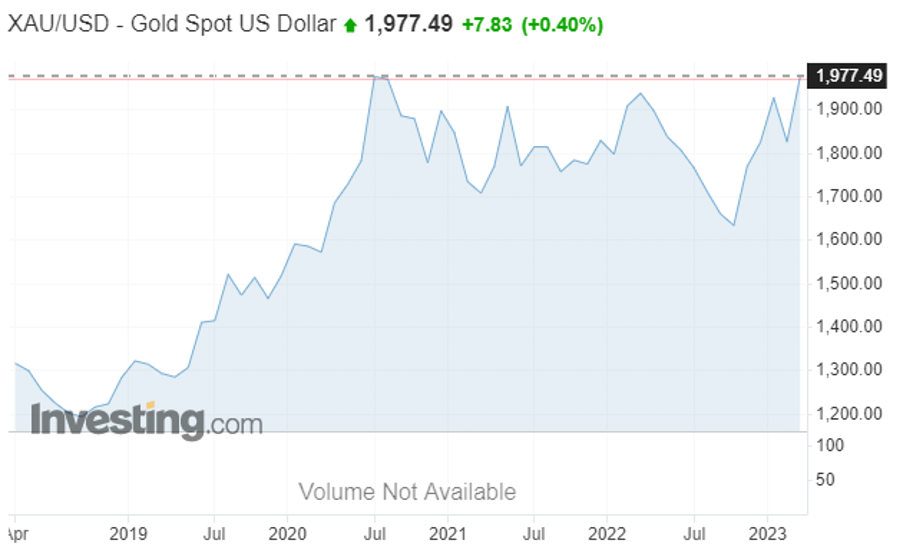Volatilidad del mercado
El precio del oro viene determinado por las fuerzas de la oferta y la demanda. La historia nos enseña que los inversores suelen utilizar el oro como activo refugio en periodos de incertidumbre o como cobertura frente a la inflación. Como consecuencia de la inquietud de los mercados, la demanda de oro está aumentando. Según el Consejo Mundial del Oro, el año pasado la demanda alcanzó su nivel más alto en 11 años. A ello contribuyeron principalmente las compras de los bancos centrales, que adquirieron 1 136 toneladas de oro el año pasado. El precio del oro está recibiendo mucha atención debido a la volatilidad del mercado, que se ha visto exacerbada en gran medida por los problemas en los bancos que comenzaron con el colapso de los JGB, y posteriormente esta tendencia ha cobrado impulso también en Europa.
De hecho, el conocido banco suizo Credit Suisse también ha anunciado problemas. Algunas opiniones opinan que el pánico es innecesario y que todo volverá a la normalidad. Sin embargo, esto no está claro, ya que se especula con la posibilidad de que quiebren más bancos el año que viene. Así que, a fin de cuentas, los inversores buscan una forma fiable de evitar pérdidas más importantes en sus carteras.
El buen comportamiento del oro
Es el próximo periodo el que podría favorecer a esta materia prima. Actualmente, vemos que el oro cotiza a 1.940 dólares la onza. El lunes, pudimos ver que llegó a alcanzar los 2.000 dólares, que fue el nivel más alto desde marzo de 2022. Si contamos el incremento porcentual desde que comenzaron los problemas con los bancos, el oro ha ganado alrededor de un 10%.* El soporte del precio se debe principalmente al interés de los bancos centrales y esto puede aumentar aún más. La previsión para los próximos meses es clara, el buen comportamiento del oro debería continuar y el valor podría superar nuevos máximos. [1]

Desempeño del XAU/USD - Oro al contado Dólar USA durante los últimos 5 años. (Fuente: Investing)
En el pasado, hemos visto subir el precio del oro durante periodos de alta inflación, ya que los inversores han tendido a comprar menos moneda fiduciaria y más oro. Por este motivo, la política monetaria de los bancos centrales para controlar la inflación es clave para la subida del metal amarillo.
Respecto al dólar, el oro como materia prima comercializable está denominado en dólares estadounidenses, lo que crea una especie de relación inversa. Esto significa que cuando el dólar sube frente a otras divisas, el oro se encarece, lo que perjudica a la demanda. A la inversa, cuando el dólar baja, el precio del oro sube, ya que el metal se abarata para los compradores extranjeros. Todos los factores mencionados afectarán al metal amarillo en los próximos meses, por lo que es imperativo que los inversores estén atentos a la evolución gradual de la situación en torno a los bancos y al aumento de la inflación.
Olívia Lacenová, analista de Wonderinterest Trading Ltd., ha publicado un artículo sobre el oro.
*El rendimiento inmediato no es garantía de resultados futuros
[1] Las declaraciones prospectivas se basan en suposiciones y expectativas actuales, que pueden ser inexactas, o en el entorno económico actual, que puede cambiar. Estas afirmaciones no garantizan resultados futuros. Implican riesgos y otras incertidumbres difíciles de predecir. Los resultados pueden diferir materialmente de los expresados o implícitos en cualquier declaración de intenciones.